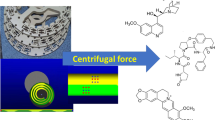Summary
Alkaloid extract of Fumaria officinalis was analysed by the “moist buffered paper” technique using 15 water — immiscible solvents of various molecular structures and donor — acceptor properties. The RF vs·pH curves were sigmoid in shape, in accordance with equations derived for ideal buffered paper chromatography and were arranged along the pH axis in two families: that of protopine (protopine, cryptocavine, F37 and F38) and of protoberberine (stylopine, sinactine and aurotensine); the two families of RF vs·pH curves were divided for most water — immiscible solvents investigated by a gap of 1.5 to 2.0 pH units which indicated a high selectivity of the solvent systems. The sequence of alkaloids for solvents of class A and AB was different from that for solvents of class N and B (the symbols, introduced byPimentel andMcClellan, denote electron — acceptor, donor — acceptor, neutral and donor solvents, respectively). RM values of the component alkaloids, plotted against the solvents investigated, gave “chromatographic spectra” which were in general parallel with the exception of the two alkaloids possessing phenolic groups (aurotensine and F38) whose spectra showed deviation for some solvents of class B due to specific H — bonding between the solute and solvent.
Zusammenfassung
Alkaloidextrakt von Fumaria officinalis wurde mit der Methode der „Feuchtpuffer”-Papierchromatographie unter Verwendung von 15 mit Wasser nicht mischbaren Fließmitteln verschiedener Molekularstruktur und Donor-Akzeptor-Eigenschaften untersucht. Die Rf=f(pH) — Kurven sind, im Einklang mit den Gleichungen für ideale Papierchromatographie, S-förmig. Sie zerfallen in 2 Gruppen: die Protopin-Familie (Protopin, Cryptocavin, F37 und F38) und die Protoberberin-Familie (Stylopin, Sinactin und Aurotensin). Der Abstand beider Kurvenfamilien von 1,5–2 pH-Einheiten weist auf große Selektivität der Lösungsmittelsysteme hin. Fließmittel der Klassen A und AB gaben andere Fleckreihenfolge als solche der N- und B-Klasse (die vonPimentel u.McClellan eingeführten Symbole bedeuten Elektronakzeptor-, Donor-Akzeptor-, neutrale und Donor-Lösungsmittel). Auftragen der RM-Werte gegen die Fließmittel ergibt „chromatographische Spektren”, die im allgemeinen parallel verlaufen außer im Falle von 2 phenolischen Alkaloiden (Aurotensin und F38), deren Spektren bei Fließmitteln des B-Typs aufgrund von Wasserstoffbrücken Abweichungen zeigen.
Sommaire
Un extrait d'alcaloide de Fumaria officinalis a été examiné à l'aide de la chromatographie sur papier avec “tampon humide”, en utilisant 15 solvants non miscibles avec l'eau, ayant des structures moléculaires et des qualités de donateur-accepteur différentes. Conformément aux équations pour chromatographie sur papier idéale, les courbes établies pour Rf=f (pH) ont la forme d'un S. Elles se divisent en deux groupes: la famille des protopines (Protopine, Cryptocavine, F37 et F38), et la famille des protoberberines (Stylopine, Sinactine, Aurotensine). La distance de 1,5 à 2 unités pH entre les courbes des deux familles signale une haute sélectivité des systèmes des solvants. Les solvants des classes A et B donnent une autre séquence des taches que ceux des classes N et B (les symboles introduits par Pimentel et McClellan signifient solvants accepteurs d'électrons, solvants donateurs-accepteurs, solvants neutres, et solvants donateurs). Si l'on établit un graphique des valeurs RM relatives aux solvants, on obtient des “spectres chromatographiques” qui en règle générale sont parallèles, sauf pour 2 alcaloides phénoliques (Aurotensine et F38), dont les spectres font apparaître des déviations pour les solvants du type B à cause de ponts d'hydrogène.
Similar content being viewed by others
References
Manske, R.H.F., Canad. J. Research, 1938,16B, 438
Susplugas, L, M. Lalaurie, G. Privat andR. Got, Trav. Soc. Pharm., Montpellier, 1961,21, 28
Hakim, S.A.E., V. Mijovic andJ. Walker, Nature 1961,189, 198
Waksmundzki, A., E. Soczewinski andR. Aksanowski, Chemia Analit., (Warsaw), 1957,2, 459
Waksmundzki, A. andE. Soczewinski, Nature, 1959,184, 977
Waksmundzki, A. andE. Soczewinski, Roczniki Chemii, 1958,32, 863; 1959,33, 1423; 1961,35, 1363
Waksmundzki, A. andE. Soczewinski, Bull. Acad. Polon. Sci., ser. chim., 1961,9, 155
Przyborowska, M., Dissert. Pharm. (Cracow), 1965,17, 497
Jusiak, L., E. Soczewinski andA. Waksmundzki, Dissert. Pharm. et Pharmacol., 1966,18, 479
Jusiak, L., Acta. Pol. Pharm., 1966,23, 247
Przyborowska, M., E. Soczewinski, A. Waksmundzki andW. Golkiewicz, Dissert, Pharm. et Pharmacol., 1967,19, 289
Jusiak, L., E. Soczewinski andA. Waksmundzki, Acta Pol. Pharm. 1967,24, 619
Ewell, R.H., J.M. Harrison andL. Berg, Ind. Eng. Chem., 1944,36, 871
Pimentel G.C. andA.L. McClellan, “The Hydrogen Bond”, Freemann, San Francisco-London-N.Y., 1960
Collander, R., Acta Chim. Scand., 1949,3, 717: 1950,4, 1085
Bush, I.E., Methods of Biochem. Anal., 1965,13, 357
Soczewinski, E. andW. Maciejewicz, Separation Science, 1967,2, 293
Author information
Authors and Affiliations
Rights and permissions
About this article
Cite this article
Wawrzynowicz, T., Waksmundzki, A. & Soczewiński, E. Partition chromatography and countercurrent distribution of alcaloids of Fumaria officinalis. Chromatographia 1, 327–331 (1968). https://doi.org/10.1007/BF02257027
Published:
Issue Date:
DOI: https://doi.org/10.1007/BF02257027




